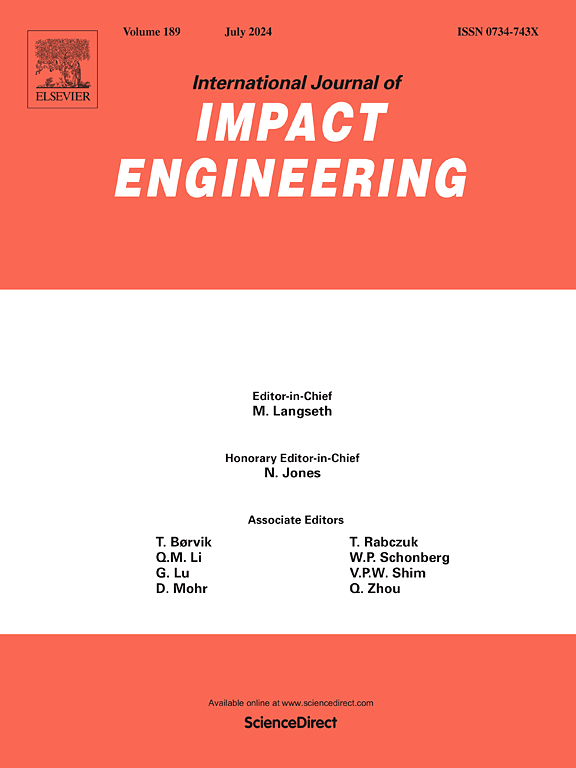再现高温下石墨超高速冲击的双激光实验
IF 5.1
2区 工程技术
Q1 ENGINEERING, MECHANICAL
International Journal of Impact Engineering
Pub Date : 2025-04-19
DOI:10.1016/j.ijimpeng.2025.105375
引用次数: 0
摘要
毫米或亚毫米炮弹的超高速撞击(HVI)可以以几公里/秒的相对速度撞击航空航天结构。本文研究了温度在300 ~ 3600 K范围内对HVI在石墨靶上产生的弹坑尺寸的影响。这项研究是通过开发一种基于使用两种高功率激光器的原始实验装置而实现的:一种纳秒冲击激光器提供高达40 J的冲击,以模拟260 μ m直径的铝弹以2至4 km/s的速度撞击,另一种连续波加热激光器以短的加热时间和良好控制的加热斜坡达到非常高的温度。研究表明,在3400 K以下,陨石坑的最大深度和直径不随温度的变化而变化,但陨石坑的体积略有增加。这可以用陨石坑在高温下更完整的形成来解释。这种行为在目前的文献中还不清楚,可能是由于高温升华的影响,目前的方法可以考虑到这一点。在3400 K以上,观察到陨石坑尺寸迅速减小。本文章由计算机程序翻译,如有差异,请以英文原文为准。

Two-laser experiments to reproduce hypervelocity impacts on graphite at high temperature
Hypervelocity impacts (HVI) with millimeter or submillimeter projectiles can strike aerospace structures with relative velocities of several km/s. In the present paper, the effect of temperature, in the range of 300 to 3600 K, on the size of the craters produced by HVI on graphite targets is studied. This study was made possible by the development of an original experimental setup based on the use of two high-power lasers: a nanosecond shock laser delivering up to 40 J to simulate impacts of 260 µm diameter aluminum projectiles at velocities ranging from 2 to 4 km/s, and a continuous-wave heating laser in order to reach very high temperatures with a brief heating time and well-controlled heating ramp. This study shows that maximum depth and diameter of craters do not vary with the temperature up to 3400 K, but a slight increase of the crater volume is observed. It is explained by a more complete formation of the crater at high temperature. This behavior was not clear up to now in the literature, probably because of the effect of sublimation at high temperature which can be taken into account by the present methodology. Beyond 3400 K, a rapid decrease of crater dimensions is observed.
求助全文
通过发布文献求助,成功后即可免费获取论文全文。
去求助
来源期刊

International Journal of Impact Engineering
工程技术-工程:机械
CiteScore
8.70
自引率
13.70%
发文量
241
审稿时长
52 days
期刊介绍:
The International Journal of Impact Engineering, established in 1983 publishes original research findings related to the response of structures, components and materials subjected to impact, blast and high-rate loading. Areas relevant to the journal encompass the following general topics and those associated with them:
-Behaviour and failure of structures and materials under impact and blast loading
-Systems for protection and absorption of impact and blast loading
-Terminal ballistics
-Dynamic behaviour and failure of materials including plasticity and fracture
-Stress waves
-Structural crashworthiness
-High-rate mechanical and forming processes
-Impact, blast and high-rate loading/measurement techniques and their applications
 求助内容:
求助内容: 应助结果提醒方式:
应助结果提醒方式:


